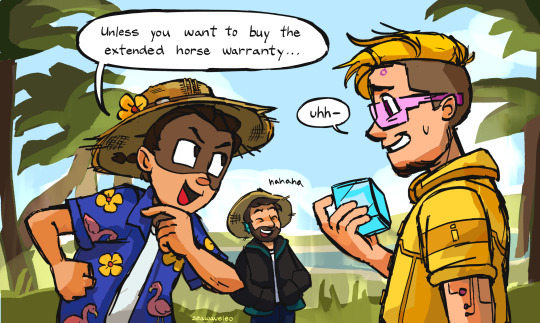#ef-4
Text
Would you keep driving??
232 notes
·
View notes
Photo

Day 3: Little Joe
Info from Wikipedia:
The Little Joe is a type of railroad electric locomotive built by General Electric. The locomotives had twelve axles, eight of them powered, in a 2-D+D-2 arrangement. They were originally intended to be exported to the Soviet Union and designed to operate on Soviet Railways (SZhD) 3,300-volt DC overhead line system. They were never exported to the Soviet Union due to rising political tensions. Only 20 were built, with 15 sold to domestic operators and five exported to Brazil.
After World War II, the Soviet Railways continued its electrification program, this time targeting the Kropachyovo-Zlatoust-Chelyabinsk line of the South Urals Railway. As local factories were recovering from the war efforts, the Soviet government (then led by Joseph Stalin), ordered 20 of these locomotives. Known by their factory classification of GE 2-D+D-2 406/546 8-GE 750-3300V, in the Soviet Union, they would have received the classification of the A-series locomotive, with the A standing for Amerikanskiy elektrovoz (Russian: Американский электровоз), meaning "American locomotive". At the time, this was the strongest electric locomotive, producing a power of 4320 kW, being comparable to the Union Pacific Big Boy.
The locomotives were built by General Electric (GE) at Erie, Pennsylvania, with the supervision of Soviet specialists. The Ministry of Railways of the USSR was so confident about receiving these locomotives, that they were also allocated running numbers, initially 1591-1610 and later 2301-2320. The first test run of the locomotive (unit A1598) took place on 7 September 1948 on a test track of the New York Central Railroad.
GE built 20 locomotives of this type, but the company was prohibited from delivering them as relations between the United States and Soviet Union deteriorated into what became known as the Cold War. Fourteen were built to the track gauge of 5 ft (1,524 mm) and the final six were built to 4 ft 8+1⁄2 in (1,435 mm) standard gauge.
The locomotives were never delivered because the State Department banned sales of strategic goods to the Soviet Union whilst production was underway. This included the electric locomotives, which were considered strategic to the Soviet Railways. Before the ban, the tensions between the US and USSR caused the Soviet railway engineers to be recalled back to their country. GE completed the locomotives, but they were left with no owner. Two were damaged during the trials. Although minimal, unit 29924 collided with unit 29923, causing significant damage to the leading axle.
The Soviet Union was then forced to design its own locomotive, the N8 (later VL8), which only ran in 1953. This led to the development of the VL10 (3kV DC) and VL80 (25 kV AC) locomotives.
The Milwaukee Road had offered to buy all 20 locomotives, plus their spare parts, for $1 million. That was little more than scrap value, but GE accepted. However, the Milwaukee's Board of Directors would not release the money. Nonetheless, unit 29927 was tested on 24 December 1948 on the Milwaukee Road, but it revealed some issues during trials.
Demand during the Korean War boosted the Milwaukee's need for locomotives on their electrified mainline. The railroad was also beset by a coal strike that required sending most diesels back East (Milwaukee Lines East steam engines still burned coal, unlike the oil-burning Lines West steamers). So the Board of Directors returned to GE, only to discover that eight locomotives and all the spare parts had been sold. Three had gone to the Chicago South Shore & South Bend Railroad (the South Shore Line), and five to the Companhia Paulista de Estradas de Ferro of Brazil.
Still, the Milwaukee Road bought the remaining 12 locomotives for $1 million. The railroad designated its new locomotives as "class EF-4", denoting them as the line's fourth model of electric freight engine. Two units were modified before delivery for passenger service; these were designated "class EP-4". The Milwaukee's operating employees referred to the EF-4/EP-4 units as Little Joseph Stalin's locomotives, which was eventually shortened to simply Little Joe.
As originally tested, the Milwaukee was not impressed with these locomotives, finding them prone to wheelslip. The World War I-vintage General Electric motor-generator substations had difficulty supplying more than two EF-4s under heavy load, which meant that their true ability could not be demonstrated. Additionally, the controls were initially labelled in Russian. After being modified with increased weight, raising the maximum height of the pantographs and being provided with adequate power, the EF-4s were excellent performers and very reliable. Some substations were later modified to supply up to 3,400 volts to take advantage of the high power of these locomotives.
The E20 and E21 locomotives became EP-4 engines to be used for passenger service. They were modified before delivery to remove driving controls and windows at one end to permit moving new, improved main circuit breakers into a cooler environment. The Milwaukee Shops replaced the operating controls in the "B" end with a steam generator before they entered service. The loss of this cab was operationally inconsequential, as many Milwaukee electric locomotives were normally turned at the end of their runs in Avery, Deer Lodge or Harlowton, the road having preferred to maintain only one set of controls even on double-ended units. The most important and final major modification was the provision of multiple unit controls for trailing diesel-electric locomotives. This system was designed in-house. It was not uncommon to see several diesel-electric locomotives being led by, and controlled from, one or two Joes (or a set of Boxcabs) in the 1960s and 70s.
The external difference that most readily distinguished class EP-4 from EF-4 was the use of roller bearings on all axles on the E20 and E21 as delivered. The EF-4s were delivered with roller bearings on the forward (unpowered) trucks only, though they would have individual roller bearing axles substituted piecemeal in the shop whenever original plain bearing axles on the motorized sets burned out or were wreck-damaged.
Like almost any locomotive class, the Little Joes were occasionally involved in accidents. One such, in 1966, resulted in the E78 being rebuilt (back east in the Milwaukee Shops) to a slightly different appearance from the other 11 units, due to the use of a pair of stainless steel side ventilation grilles intended for use on EMD F-units.
The Milwaukee Road used two for passenger service, designated class EP-4 (2-D+D-2), and the remaining ten for freight, designated class EF-4. They were used on the railroad's electrified Rocky Mountain Division in Montana and Idaho to take the place of older GE boxcab electrics that had been operating there since the 1920s. They were never used on the road's electrically disjunct Coast Division in Washington, as none of that division's substations were upgraded to accommodate them. Three had been delivered in standard gauge, while the rest were converted to standard gauge in the Milwaukee's shops.
The EF-4s performed well, so much so that Milwaukee management soon desired to utilize the two EP-4s exclusively on freights. This was being done by 1956, when the passenger Joes were replaced by newly migrated EP-2 Bipolars. After the latter turned out to be ill-suited to the Rocky Mountain Division, they and the EP-4s were replaced by three-unit consists of EMD E-unit and/or FP7 diesels which hauled the Olympian Hiawatha end-to-end, unassisted, until its discontinuation in 1961. Neither EP-4 received the post-1955 Union Pacific-inspired Armour Yellow, red and gray paint scheme used on Milwaukee passenger power, such as the Bipolars and GE Passenger Motors.
The Little Joes lasted until the end of electric operation on the Milwaukee on June 15, 1974. By that time, they were the Milwaukee's only electric road locomotives, all the GE Freight Motors (except two which were used together in MU as the Harlowton switcher) having succumbed to old age.
The South Shore, while primarily a commuter railroad between Chicago, Illinois, and northwestern Indiana, used them in freight service. hey were modified to operate on 1500 V DC catenary, and were delivered with roller bearings on all axles as on the Milwaukee EP-4s. In service on the South Shore the "Little Joe" name was not generally used; they were called "800s". Two of the three lasted until 1983, making them the last electrics in regular mainline freight service on a US common-carrier railroad. Today, freight trains are pulled by diesel-electric locomotives.
Two 800s survive today, 802 at the Lake Shore Railroad Museum, and 803 in running condition at the Illinois Railway Museum.
The Companhia Paulista de Estradas de Ferro converted its locomotives to its 5 ft 3 in (1,600 mm) gauge. They became known as Russas, and stayed active through each re-organization of the Brazilian railways, finally ending up with FEPASA in 1971.
These were the most powerful electric locomotives in the country. On this railway, the locomotive of number 6454 gained the title "Engenheiro Jayme Cintra" - a tribute for an important person of the Paulista Railway history: he was the responsible for electrification of the main Brazilian railway of that season.
They continued to operate until 1999, becoming the last units of their class in revenue service. It was at this point that FEPASA was privatized, and electric operation was ended.
Surviving Little Joes:
Milwaukee Road #E70 is on static display at Deer Lodge, Montana.
South Shore #803 is preserved, in operational condition, at the Illinois Railway Museum (IRM). South Shore #802 is preserved and on public display at the Lake Shore Railway Historical Museum in North East, Pennsylvania, 10 miles (16 km) away from Erie, where the GE Locomotive Assembly Plant that constructed the Little Joes is located.
In Brazil, 6451, 6453, and 6454 were scrapped after the deactivation. Number 6452 is in a museum in Jundiaí, São Paulo and #6455 is in a museum in Bauru, São Paulo, but is missing many parts. As of 2008, 6455 was transferred in safe for the stop-station gare and now is safe in a rail station-museum.
Models and Route By: RRmods, Auran, and Download Station
#Milwaukee Road#MILW#Chicago Milwaukee St. Paul and Pacific#Milwaukee#Little Joe#EF-4#Electric Locomotive#Trains#Trainz Simulator#Advent Calendar#Christmas#Christmas 2022 🎄🎅🎁
2 notes
·
View notes
Text

enjoying season 10 immensely
#keralis#impulsesv#xbcrafted#hermitcraft#hc s10#hc10#mcyt#fanart#digital art#art#waveleoart#(how is this my first actual fanart of something that happened in game (not presaved art))#(probs bc of school lol - i’m trying not to procrastinate on film this year like last year by doing fanart but…)#(since my sleep schedule is so royally effed up tonight i will draw)#(it’s 4:23am when i’m writing this so if i get the time i’ll add the id tomorrow.. hopefully)
2K notes
·
View notes
Text
I was hoping for Grucy fanfictions after DM4 but all I got are fanfics about Gru cheating on Lucy with that cockroach villain like wtf is even this fandom

#i wanna know how this sounds for those who aren't in the fandom lmfao#but like why#first y'all make him f with dru who's his effing brother and now this#grucy is the healthiest ship i know and yet they have so little appreciation#grucy#maxime le mal#gru#despicable me 4
131 notes
·
View notes
Text

door 4 vs door 5 in a nutshell
#watching a friend play through the nonary games edition and they held off on door 4 for SO long#it's such funny payoff when they remember how snake explains it in detail only to have june do the same effing thing#that one meme but it goes “listen to my astrological signs boy”#ze#zero escape#999
80 notes
·
View notes
Text







PRESENTING THE SO FAR LONGEST ISSUE OF
ef-sc magazine, edition 05:
"monochromatic" with cecelia, mina, arlene & fallon *in order of appearance*
inspo / resources (pinterest board)

just in time for 200 followers!! i don't know how we got here so fast and i apologize for taking so long to make this edit but i think it was worth it, these are some of my favourite renders i've made!! also hello?? 7 slides!!! anyways THANK YOU for 200!! hope you enjoy 😚
#*cecelia#*arlene#simblr#ts4#the sims 4#sims 4#ts4 edit#sims 4 edit#s4 edit#ts4 render#sims 4 render#sims render#ef sc magazine
252 notes
·
View notes
Text


HE’S MAKING IT SO OBVIOUS BYE
#nick valentine#john hancock#Nick Valentine x John Hancock#valencock#fallout 4#nick valentine fallout 4#john hancock fallout 4#Hancock#hancock fo4#nick valentine fo4#tumblr fyp#he wants that cookie so effing bad#stupid ass name
86 notes
·
View notes
Text



#nah.#this effed up show.#this effed up show that we obsess over incessantly infatuatedly hysterically#🤷#(‼️hand hygiene‼️)#bbc sherlock#sherlock bbc#sherlock#sherlock s1#the great game#tgg#sherlock s4#sherlock season 4#the lying detective#tld#eurus holmes#jim moriarty#tjlc#buckingham-ashtray
54 notes
·
View notes
Text

Çok güzellerr ❤🖤
#gabriel guevara#nicole wallace#nick leister#noah morgan#3391kilometre#izmir aksoy#sıfırkilometre#ömer ege zorlu#egeninizmiri#egeninincisi#karantina#onur zorlu#zeynep akay#mahşerin 4 atlısı#no.26#ykk#efe duran#spotify#gasoline#culpa mia#my fault#sonsuz aşk#siyah ve beyaz#siyah kadar yalniz#ay benim gece senin#gecenin karanlığı#elena gilbert#damon salvatore#the vampire diaries#the summer i turned pretty
439 notes
·
View notes
Text


So I opened my game and Carlos woke up with facia hair. I don't EVER WANT TO SHAVE IT OFF!!!! 😭😭😭😭😭😭😭😭
#Matter of fact I'm upgrading his entire effing closet#carlos morales*#the sims community#sims 4 gameplay#ts4 simblr#sims 4 story#simblr#he went from Carlos to Mr. Morales real quick!!!#the sims 4#sims 4 cc#sims4#ruthplaysthesims#if i had to see this so do you
50 notes
·
View notes
Text
I just found out that there has never been an instance where a Left 4 Dead survivor has said the word "Fuck" despite the game's mature rating. So naturally I decided I'm going to make Left 4 Dead 3 and it's going to feature Keith as a character, and in the intro of the game his very first line will be "WHAT'S UP FUCKERS!?"
#At some point in L4D2 Coach says “I effed this up” but that DOESN'T COUNT#l4d2#left 4 dead 2#left 4 dead 3????????????#left 4 dead#l4d#Keith#kebby rambles
57 notes
·
View notes
Text

“wŵĥęŕē ťŧţø ŋņĕxť‽”
@fransweek Day 4 - Travel
Error Sans by loverofpiggies
#undertale#frans#sans#frisk#error sans#fransweek#frans week#frans week 2023#frans week 2023 day 4#undertale au#errortale#error sans x frisk#frisk x error sans#sans x frisk#frisk x sans#fun fact this is the first picture i drew for this frans week#cuz i knew ill spend a ton of time on all the backgrounds#another fun fact - i used no references for those bgs so#if you wonder if they dont look that good XD#also i absolutely messed up his outfit cuz top is from his redesign and bottom out of. my head idk i just effed it up lmao
411 notes
·
View notes
Text


been rewatching the Persona 4 anime and I miss these goofy ahh kids
#thinking of getting p4g on steam#even tho this would be my 3rd time buying p4 lol#the dump#persona 4#yukichie#souyo#LOL yk what really made me mad#I bought a vita 4 years ago just to play golden before all these effing ports#it’s so accessible now#I mean I’m glad for it bc more people get to play it#but my vita doesn’t even have its portable perk anymore bc they’re porting to switch too 😭😭
919 notes
·
View notes
Text
oh great in episode 6 of 4 minutes my beloved. he's so fucked up. i love him.
#can you believe this was the best episode of the whole show so far#it was so messed up this is all i wanted from this show#like is it my birthday or something#im so obsessed#everyone was displaying unhinged behavior and i am here for it#also great is so multifaceted#like he's not a bad person perse but he does do bad things#due to his upbringing and his complacency and his fear cause he is a bit of a coward yes#but like he does feel bad about the effed up stuff he's done#he is just trying to drown it out and ignore it#i just love it when a character is allowed to do the absolutely wrong thing sometimes#and suffer the consequences of their actions#while still also not being an awful awful person deep down#great is a person that's not that good but not that evil either#and he is lonely af and deep down seeking genuine human connection and doesn't even realize it#love that#4 minutes#4 minutes the series
28 notes
·
View notes
Text




ef-sc magazine, edition 04:
"bluemarine" with kim takahashi
but it takes a slight, unexpected turn...
[ inspired by this dazed korea shoot ]
probably my last post before christmas, so merry christmas to everyone celebrating!
#*kim#simblr#sims 4 edit#ts4#the sims 4#s4 edit#ts4 edit#showusyoursims#sims 4 render#ts4 render#sims render#sims 4#ef sc magazine
98 notes
·
View notes



